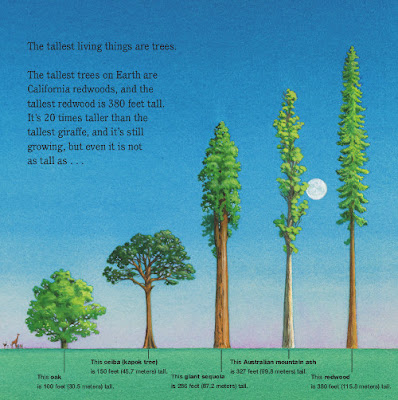"The tallest living things are trees.
The tallest trees on Earth are
California redwoods, and the
tallest redwood is 380 feet tall.
It's 20 times taller than the
tallest giraffe, and it's still
growing, but even it is not
as tall as ... "
Seeing a new book by Jason Chin is a sure invitation to learning more than you already know. In this one, he takes his readers from the planet they call home out into the far reaches of space. In illustrations that provide perspective and understanding for just how big the universe is, he captures attention and offers points for discussion for everyone who reads this amazing book.
The four 8-year-olds who are present on the book's opening page are sky watchers, as seen by the telescope they are using to make observations. He shows readers that it would take five copies of this book to be as tall as they are. A note at the bottom of the verso says that their average size is 50 inches (127 centimeters) tall. An interloper arrives at the edge of the recto with a statement that notes the children are only 'half as tall ... '
As an ostrich! One of the children standing on the shoulders of another is not quite as tall as the huge bird. The ostrich is only half as tall as ... a giraffe. Compared to an ever-taller line of trees, the giraffe seems like a shrimp! Those trees have nothing on the tallest buildings in the world (from the Eiffel Tower at 324 meters to the under-construction Jeddah Tower which will be 1 full kilometer tall!) Attention is then drawn to mountains, to space, to the far reaches of the exosphere. Wow!
Earth is compared to the moon, the sun, the other planets, and beyond.
"Our galaxy.
The Milky Way galaxy is 100,000 light-years
across and contains more than 100 billion
stars. There are so many stars that from a
distance they blend together and look like
swirling clouds of light. We are 27,000
light-years from the center of the galaxy,
which means that even if you could travel
at the speed of light, it would take you
27,000 years to get there!"
And there is more! Pages more, moving readers to a place where scientists can see the edge of the 'observable universe'. At the end of the book, Jason Chin reviews all that he has revealed to readers with short paragraphs that make the journey one more time. Finally, he provides a note from the author, a note on the age of the universe, and a note about the illustrations. These notes are followed by a list of selected sources, and websites where interested readers can find even more information.
We are so small in the grand scheme of things. Amazing? Indeed! And worthy of attention for every home, classroom and library.













No comments:
Post a Comment